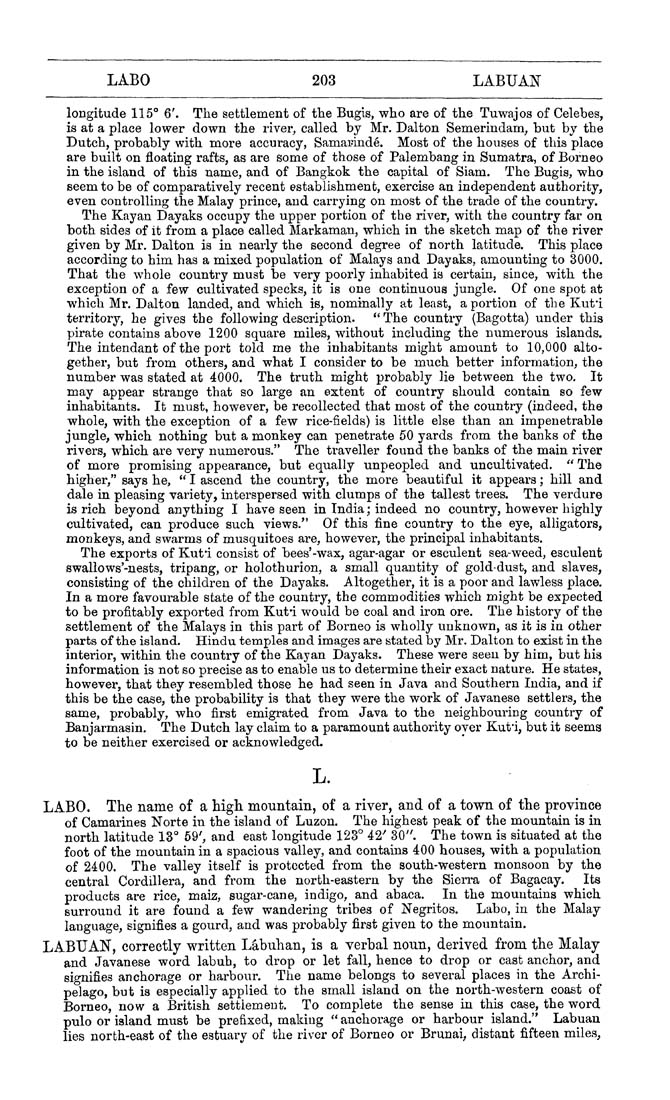LABO 203 LABUAN
longitude 115° 6'. The settlement of the Bugis, who are of the Tuwajos of Celebes,
is at a place lower down the river, called by Mr. Dalton Semerindam, but by the
Dutch, probably with more accuracy, Samarinde. Most of the houses of this place
are built on floating rafts, as are some of those of Palembang in Sumatra, of Borneo
in the island of this name, and of Bangkok the capital of Siam. The Bugis, who
seem to be of comparatively recent establishment, exercise an independent authority,
even controlling the Malay prince, and carrying on most of the trade of the country.
The Kayan Dayaks occupy the upper portion of the river, with the country far on
both sides of it from a place called Markaman, which in the sketch map of the river
given by Mr. Dalton is in nearly the second degree of north latitude. This place
according to him has a mixed population of Malays and Dayaks, amounting to 3000.
That the whole country must be very poorly inhabited is certain, since, with the
exception of a few cultivated specks, it is one continuous jungle. Of one spot at
which Mr. Dalton landed, and which is, nominally at least, a portion of the Kut'i
territory, he gives the following description. *' The country (Bagotta) under this
pirate contains above 1200 square miles, without including the numerous islands.
The intendant of the port told me the inhabitants might amount to 10,000 alto¬
gether, but from others, and what I consider to be much better information, the
number was stated at 4000. The truth might probably lie between the two. It
may appear strange that so large an extent of country should contain so few
inhabitants. It must, however, be recollected that most of the country (indeed, the
whole, with the exception of a few rice-fields) is little else than an impenetrable
jungle, which nothing but a monkey can penetrate 50 yards from the banks of the
rivers, which are very numerous." The traveller found the banks of the main river
of more promising appearance, but equally unpeopled and uncultivated. "The
higher," says he, " I ascend the country, the more beautiful it appears; hill and
dale in pleasing variety, interspersed with clumps of the tallest trees. The verdure
is rich beyond anything I have seen in India; indeed no country, however highly
cultivated, can produce such views." Of this fine country to the eye, alligators,
monkeys, and swarms of musquitoes are, however, the principal inhabitants.
The exports of Kut'i consist of bees'-wax, agar-agar or esculent sea-weed, esculent
swallows'-nests, tripang, or holothurion, a small quantity of gold-dust, and slaves,
consisting of the children of the Dayaks. Altogether, it is a poor and lawless place.
In a more favourable state of the country, the commodities which might be expected
to be profitably exported from Kut'i would be coal and. iron ore. The history of the
settlement of the Malays in this part of Borneo is wholly unknown, as it is in other
parts of the island. Hindu temples and images are stated by Mr. Dalton to exist in the
interior, within the country of the Kayan Dayaks. These were seen by him, but his
information is not so precise as to enable us to determine their exact nature. He states,
however, that they resembled those he had seen in Java and Southern India, and if
this be the case, the probability is that they were the work of Javanese settlers, the
same, probably, who first emigrated from Java to the neighbouring country of
Banjarmasin. The Dutch lay claim to a paramount authority oyer Kut'i, but it seems
to be neither exercised or acknowledged.
L.
LABO. The name of a high mountain, of a river, and of a town of the province
of Camarines Norte in the island of Luzon. The highest peak of the mountain is in
north latitude 13° 59', and east longitude 123° 42' 30". The town is situated at the
foot of the mountain in a spacious valley, and contains 400 houses, with a population
of 2400. The valley itself is protected from the south-western monsoon by the
central Cordillera, and from the north-eastern by the Sierra of Bagacay. Its
products are rice, maiz, sugar-cane, indigo, and abaca. In the mountains which
surround it are found a few wandering tribes of Negritos. Labo, in the Malay
language, signifies a gourd, and was probably first given to the mountain.
LABUAN, correctly written Labuhan, is a verbal noun, derived from the Malay
and Javanese word labuh, to drop or let fall, hence to drop or cast anchor, and
signifies anchorage or harbour. The name belongs to several places in the Archi¬
pelago, but is especially applied to the small island on the north-western coast of
Borneo, now a British settlement. To complete the sense in this case, the word
pulo or island must be prefixed, making " anchorage or harbour island." Labuan
lies north-east of the estuary of the river of Borneo or Brunai, distant fifteen miles.
|








